tow TOYOTA FJ CRUISER 2009 1.G Owners Manual
[x] Cancel search | Manufacturer: TOYOTA, Model Year: 2009, Model line: FJ CRUISER, Model: TOYOTA FJ CRUISER 2009 1.GPages: 432, PDF Size: 8.71 MB
Page 1 of 432
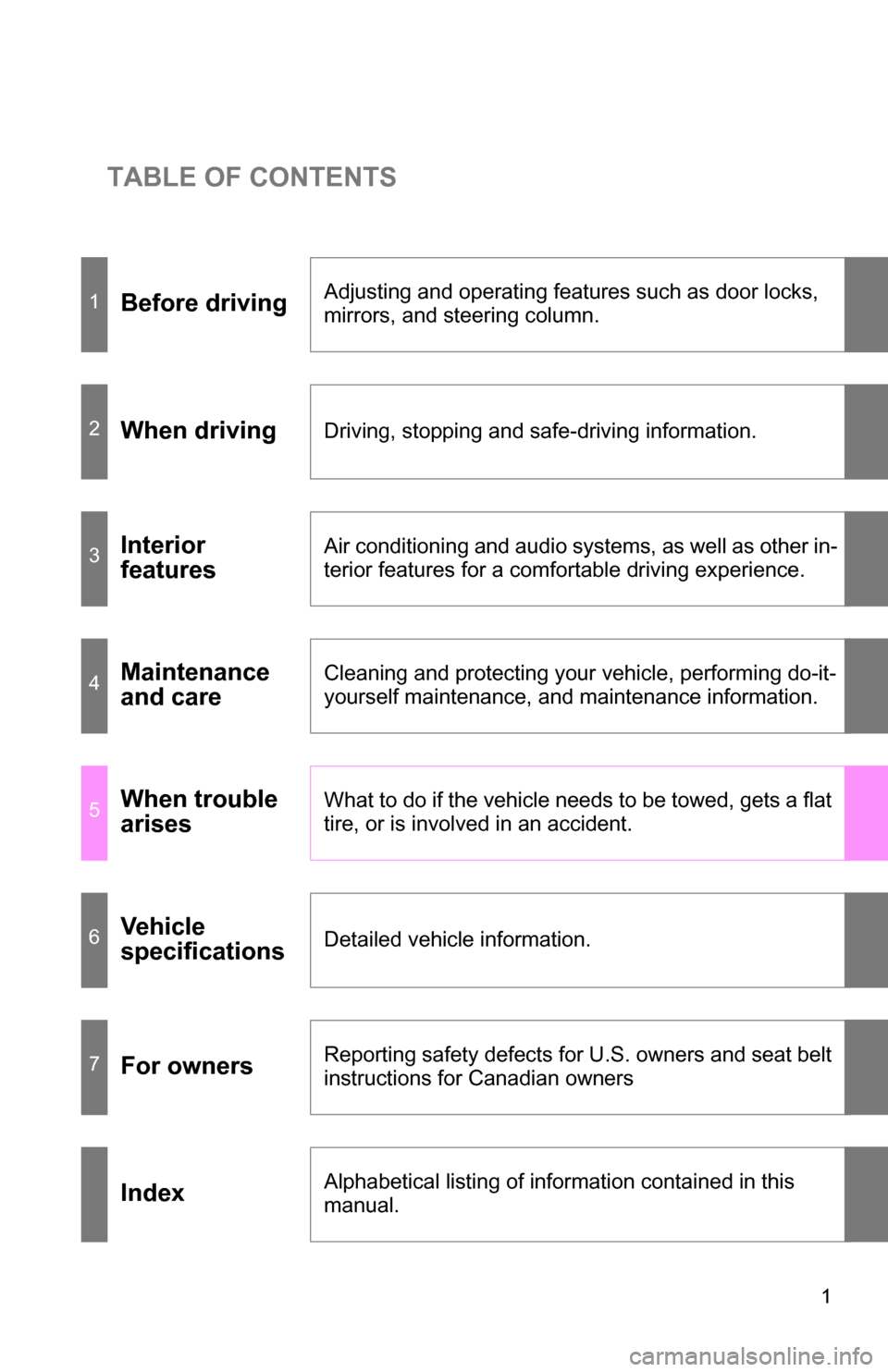
TABLE OF CONTENTS
1
1Before drivingAdjusting and operating features such as door locks,
mirrors, and steering column.
2When drivingDriving, stopping and safe-driving information.
3Interior
featuresAir conditioning and audio systems, as well as other in-
terior features for a comfortable driving experience.
4Maintenance
and careCleaning and protecting your vehicle, performing do-it-
yourself maintenance, and maintenance information.
5When trouble
arisesWhat to do if the vehicle needs to be towed, gets a flat
tire, or is involved in an accident.
6Vehicle
specificationsDetailed vehicle information.
7For ownersReporting safety defects for U.S. owners and seat belt
instructions for Canadian owners
IndexAlphabetical listing of information contained in this
manual.
Page 3 of 432
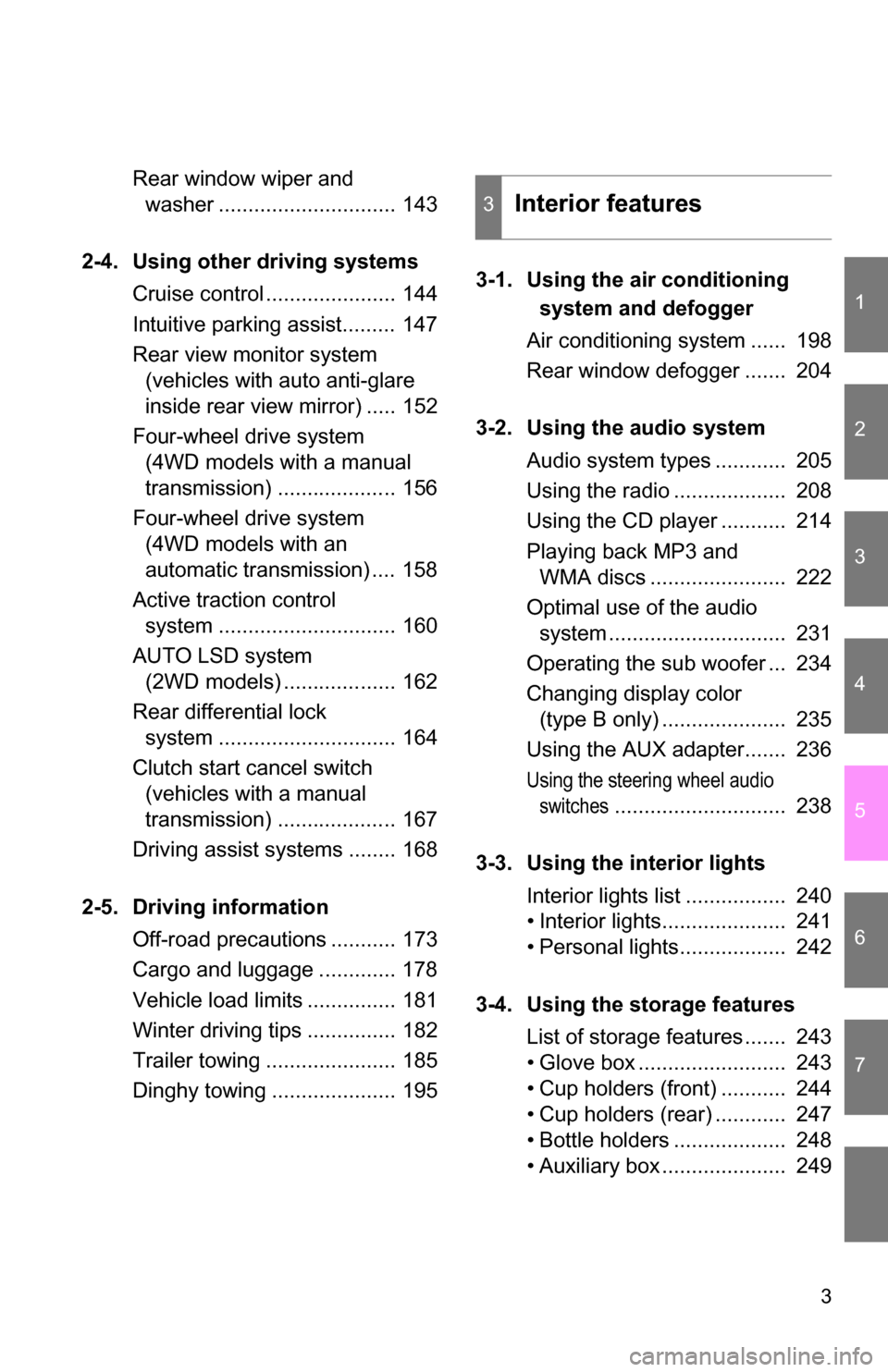
1
2
3
4
5
6
7
3
Rear window wiper and washer .............................. 143
2-4. Using other driving systems Cruise control ...................... 144
Intuitive parking assist......... 147
Rear view monitor system (vehicles with auto anti-glare
inside rear view mirror) ..... 152
Four-wheel drive system (4WD models with a manual
transmission) .................... 156
Four-wheel drive system (4WD models with an
automatic transmission) .... 158
Active traction control system .............................. 160
AUTO LSD system (2WD models) ................... 162
Rear differential lock system .............................. 164
Clutch start cancel switch (vehicles with a manual
transmission) .................... 167
Driving assist systems ........ 168
2-5. Driving information Off-road precautions ........... 173
Cargo and luggage ............. 178
Vehicle load limits ............... 181
Winter driving tips ............... 182
Trailer towing ...................... 185
Dinghy towing ..................... 195 3-1. Using the air conditioning
system and defogger
Air conditioning system ...... 198
Rear window defogger ....... 204
3-2. Using the audio system Audio system types ............ 205
Using the radio ................... 208
Using the CD player ........... 214
Playing back MP3 and WMA discs ....................... 222
Optimal use of the audio system .............................. 231
Operating the sub woofer ... 234
Changing display color (type B only) ..................... 235
Using the AUX adapter....... 236
Using the steering wheel audio switches
............................. 238
3-3. Using the interior lights Interior lights list ................. 240
• Interior lights..................... 241
• Personal lights.................. 242
3-4. Using the storage features List of storage features ....... 243
• Glove box ......................... 243
• Cup holders (front) ........... 244
• Cup holders (rear) ............ 247
• Bottle holders ................... 248
• Auxiliary box ..................... 249
3Interior features
Page 4 of 432

TABLE OF CONTENTSIndex
4
3-5. Other interior featuresSun visors .......................... 250
Vanity mirrors ..................... 251
Clock .................................. 252
Outside temperature display .............................. 253
Power outlet (12V DC) ....... 254
Power outlet (if 115V AC equipped) ......................... 255
Armrest............................... 261
Floor mat ............................ 262
Luggage storage box (vehicles without sub
woofer) ............................. 263
Luggage compartment features ............................ 264
Compass ............................ 267
4-1. Maintenance and care Cleaning and protecting the vehicle exterior ........... 274
Cleaning and protecting the vehicle interior ............ 276
4-2. Maintenance Maintenance requirements .................... 279
General maintenance ......... 281
Emission inspection and maintenance (I/M)
programs .......................... 284
4-3. Do-it-yourself maintenance Do-it-yourself service precau-tions ................................. 285 Hood ................................... 289
Engine compartment .......... 290
Tires.................................... 304
Tire inflation pressure ......... 309
Wheels................................ 313
Air conditioning filter ........... 315
Key battery ......................... 318
Checking and replacing
fuses ................................. 320
Light bulbs .......................... 331
5-1. Essential information Emergency flashers ............ 340
If your vehicle needs to be towed ................................ 341
If you think something is wrong ................................ 346
Fuel pump shut off system .............................. 347
Event data recorder ............ 348
5-2. Steps to take in an emergency If a warning light turns on or a warning buzzer
sounds... ........................... 350
If you have a flat tire ........... 360
If the engine will not start .... 372
If the shift lever cannot be shifted from P ................... 373
If you lose your keys ........... 374
If the vehicle battery is discharged ........................ 375
If your vehicle overheats..... 378
If the vehicle becomes stuck ................................. 381
4Maintenance and care
5When trouble arises
Page 31 of 432
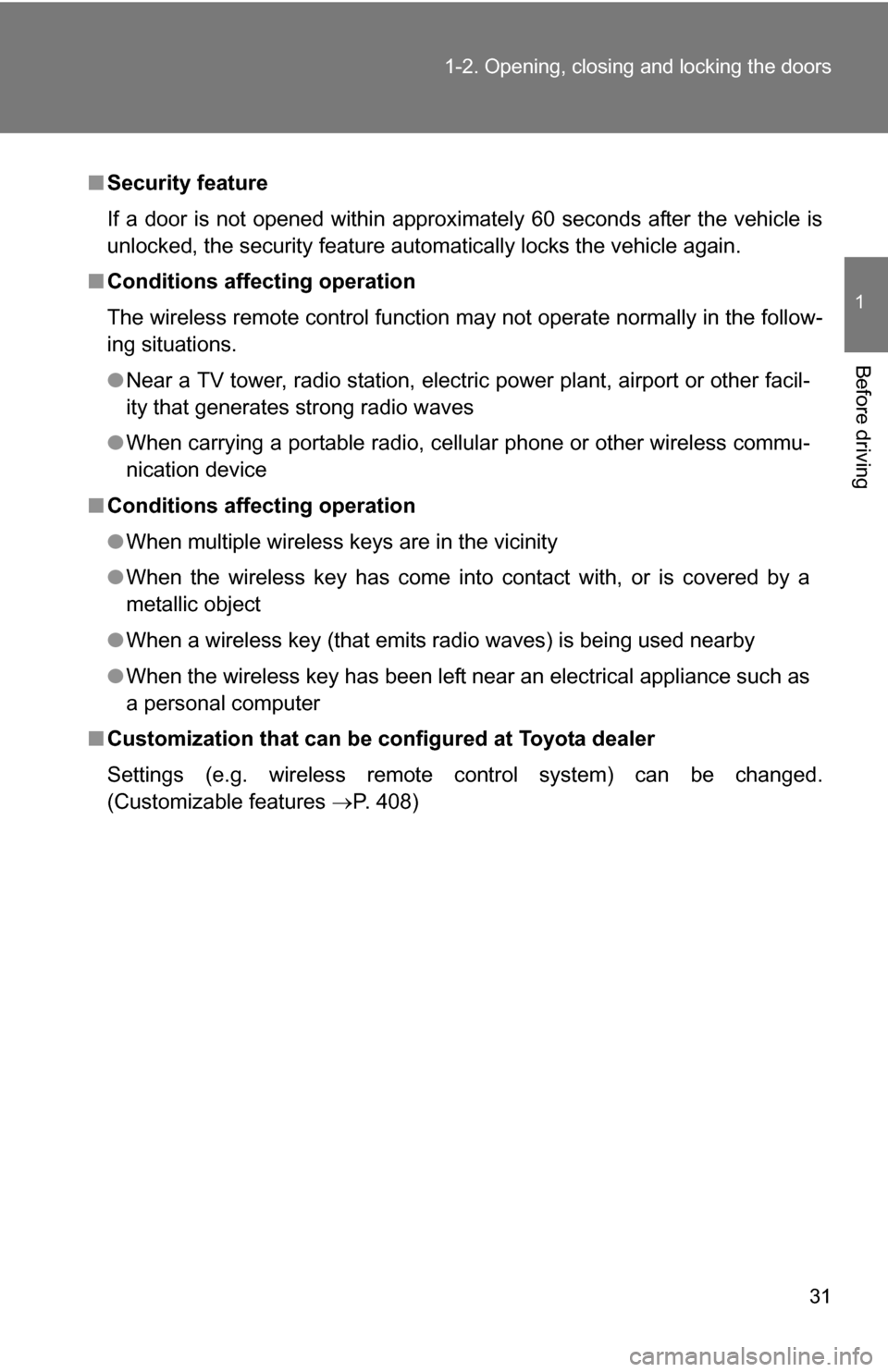
31
1-2. Opening, closing and locking the doors
1
Before driving
■
Security feature
If a door is not opened within approximately 60 seconds after the vehicle is
unlocked, the security feature automatically locks the vehicle again.
■ Conditions affecting operation
The wireless remote control function may not operate normally in the follow-
ing situations.
●Near a TV tower, radio station, electr ic power plant, airport or other facil-
ity that generates strong radio waves
● When carrying a portable radio, cell ular phone or other wireless commu-
nication device
■ Conditions affecting operation
●When multiple wireless keys are in the vicinity
● When the wireless key has come into contact with, or is covered by a
metallic object
● When a wireless key (that emits radio waves) is being used nearby
● When the wireless key has been left near an electrical appliance such as
a personal computer
■ Customization that can be co nfigured at Toyota dealer
Settings (e.g. wireless remote control system) can be changed.
(Customizable features P. 408)
Page 45 of 432
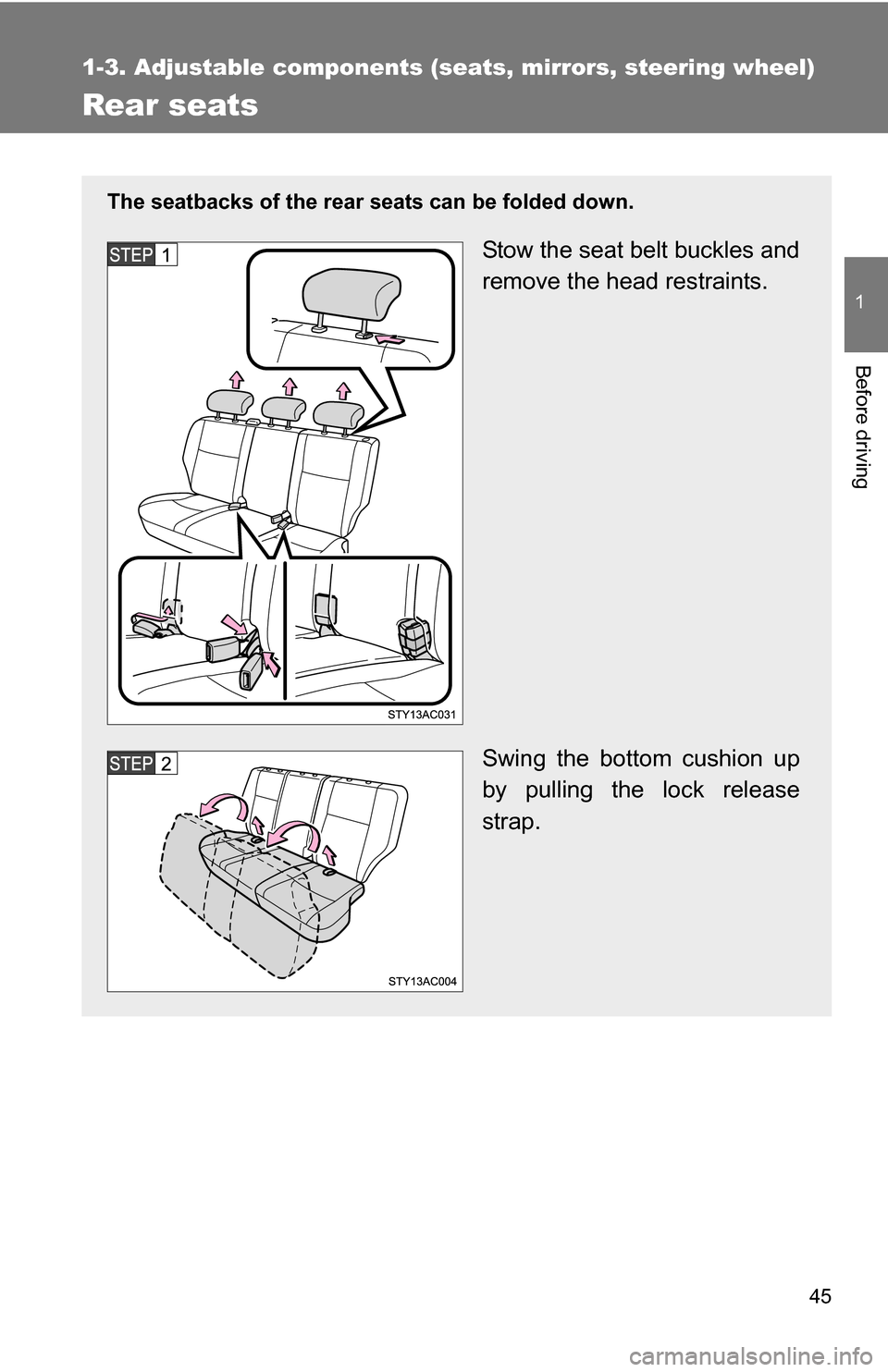
45
1
1-3. Adjustable components (seats, mirrors, steering wheel)
Before driving
Rear seats
The seatbacks of the rear seats can be folded down.
Stow the seat belt buckles and
remove the head restraints.
Swing the bottom cushion up
by pulling the lock release
strap.
Page 49 of 432

49
1-3. Adjustable components (s
eats, mirrors, steering wheel)
1
Before driving
CAUTION
■When the seatback is folded
Do not sit on or place anything on the seatback while driving.
■ When returning the seats to their original position
Observe the following precautions. Failure to do so may result in death or
serious injury.
●Be careful not to get your hands or feet pinched in the seat.
● Make sure the seatbacks and bottom cushions are securely locked. Fail-
ure to do so will prevent the seat belt from operating properly.
● Check that the seat belts are not twisted or caught under the seat.
● Arrange the seat belts in the proper positions for ready use.
■ When removing or reinstalling the bottom cushion
Observe the following precautions. Failure to do so may result in death or
serious injury.
●Do not get in the vehicle with the bottom cushions uninstalled.
● Do not leave the removed bottom cushion unsecured in the vehicle.
● Do not try to sit on or place anything on the removed bottom cushion.
● Do not drop the bottom cushion.
● Have the hexagon head bolts tightened with a torque wrench to 12.5 ft·lbf
(17 N·m, 1.7 kgf·m), or have them tightened by your Toyota dealer.
Failure to do so may cause the dials to be loosened and the bottom cush-
ions to be removed.
NOTICE
■Before folding down or removing the seats
●The seat belts buckles must be stowed.
● The head restraints must be removed before you fold down the seatback.
Page 51 of 432
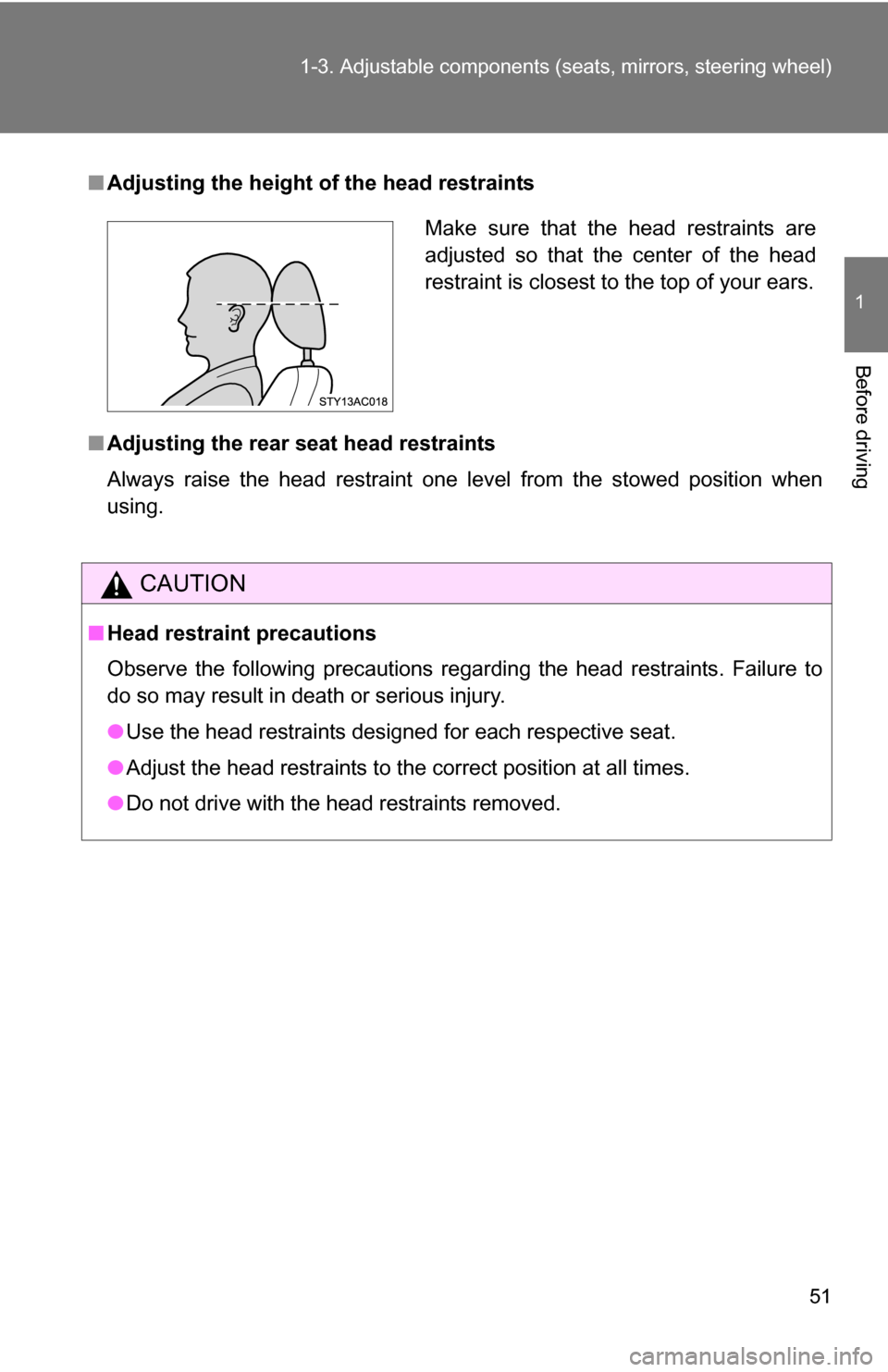
51
1-3. Adjustable components (s
eats, mirrors, steering wheel)
1
Before driving
■Adjusting the height of the head restraints
■ Adjusting the rear seat head restraints
Always raise the head restraint one level from the stowed position when
using.
CAUTION
■Head restraint precautions
Observe the following precautions regarding the head restraints. Failure to
do so may result in death or serious injury.
●Use the head restraints designed for each respective seat.
● Adjust the head restraints to the correct position at all times.
● Do not drive with the head restraints removed.
Make sure that the head restraints are
adjusted so that the center of the head
restraint is closest to the top of your ears.
Page 56 of 432

56 1-3. Adjustable components (seats, mirrors, steering wheel)
CAUTION
■Adjustable shoulder anchor
Always make sure the shoulder belt is positioned across the center of your
shoulder. The belt should be kept away from your neck, but not falling off
your shoulder. Failure to do so could reduce the amount of protection in an
accident and cause death or serious injuries in a collision. ( P. 53)
■ Seat belt pretensioners
●Do not place anything, such as a cushion, on the front passenger’s seat.
Doing so will disperse the passenger’s weight, which prevents the sensor
from detecting the passenger’s weight properly. As a result, the seat belt
pretensioner for the front passenger’s seat may not activate in the event of
a collision.
● If the pretensioner has activated, the seat belt becomes locked: it cannot
be further extended, nor will it return to the stowed position. The seat belt
cannot be used again and must be replaced at your Toyota dealer.
■ Child restraint lock function belt precaution
Do not allow children to play with the child restraint lock function belt. If the
belt becomes twisted around a child’s neck, it will not be possible to pull the
belt out leading to choking or other serious injuries that could result in death.
If this occurs and the buckle cannot be unfastened, scissors should be used
to cut the belt.
■ Seat belt damage and wear
●Do not damage the seat belts by allowing the belt, plate, or buckle to be
jammed in the door.
● Inspect the seat belt system periodically. Check for cuts, fraying, and loose
parts. Do not use a damaged seat belt until it is replaced. Damaged seat
belt cannot protect an occupant from death or serious injury.
● Ensure that the belt and tab are locked and the belt is not twisted.
If the seat belt does not function correctly, immediately contact your Toyota
dealer.
● Replace the seat assembly, including the belts, if your vehicle has been
involved in a serious accident, even if there is no obvious damage.
Page 84 of 432
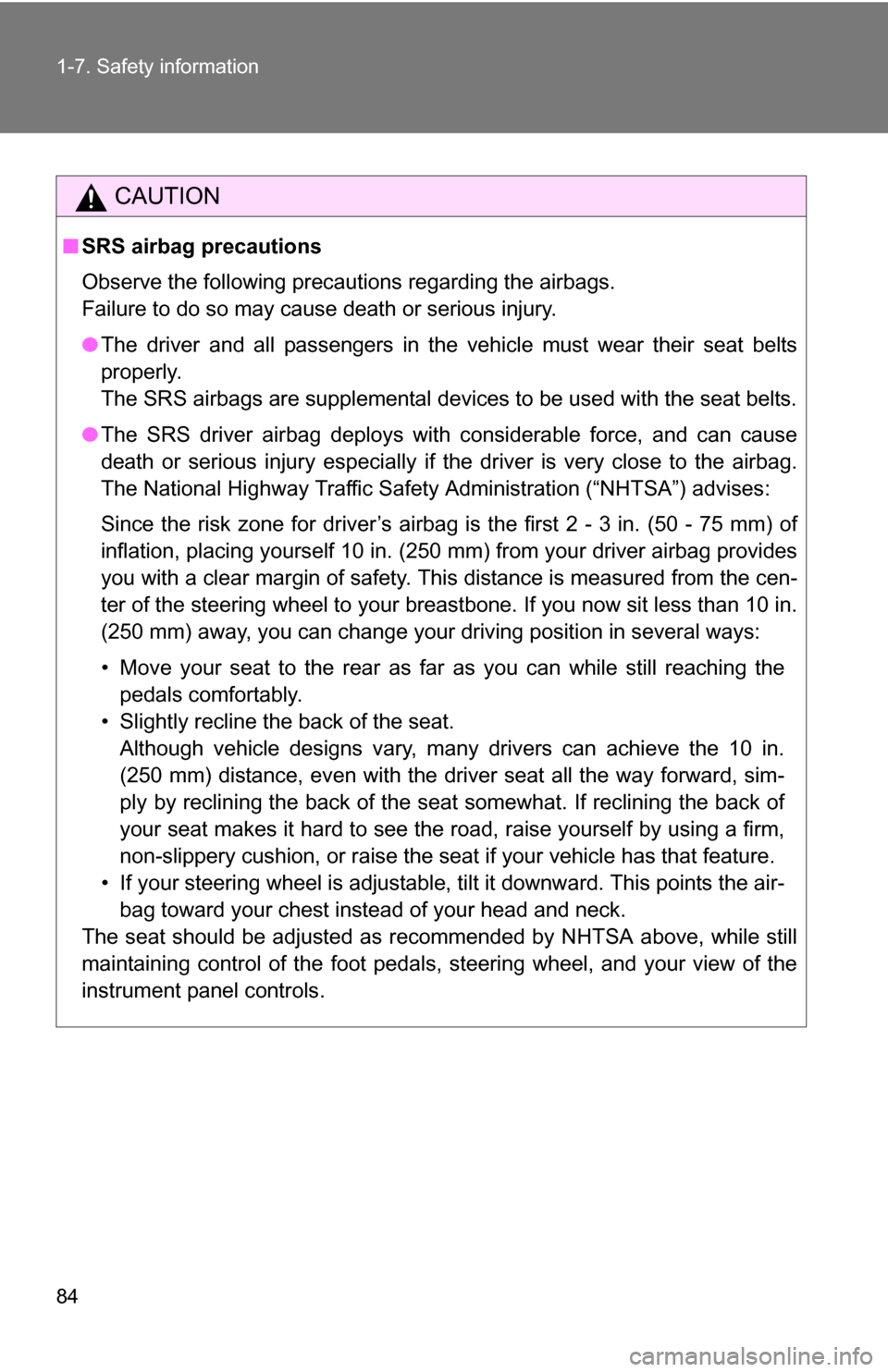
84 1-7. Safety information
CAUTION
■SRS airbag precautions
Observe the following precautions regarding the airbags.
Failure to do so may cause death or serious injury.
●The driver and all passengers in the vehicle must wear their seat belts
properly.
The SRS airbags are supplemental devices to be used with the seat belts.
● The SRS driver airbag deploys with considerable force, and can cause
death or serious injury especially if the driver is very close to the airbag.
The National Highway Traffic Safety Administration (“NHTSA”) advises:
Since the risk zone for driver’s airbag is the first 2 - 3 in. (50 - 75 mm) of
inflation, placing yourself 10 in. (250 mm) from your driver airbag provides
you with a clear margin of safety. This distance is measured from the cen-
ter of the steering wheel to your breastbone. If you now sit less than 10 in.
(250 mm) away, you can change your driving position in several ways:
• Move your seat to the rear as far as you can while still reaching the pedals comfortably.
• Slightly recline the back of the seat. Although vehicle designs vary, many drivers can achieve the 10 in.
(250 mm) distance, even with the driver seat all the way forward, sim-
ply by reclining the back of the seat somewhat. If reclining the back of
your seat makes it hard to see the road, raise yourself by using a firm,
non-slippery cushion, or raise the seat if your vehicle has that feature\
.
• If your steering wheel is adjustable, tilt it downward. This points the air- bag toward your chest instead of your head and neck.
The seat should be adjusted as recommended by NHTSA above, while still
maintaining control of the foot pedals, steering wheel, and your view of the
instrument panel controls.
Page 86 of 432
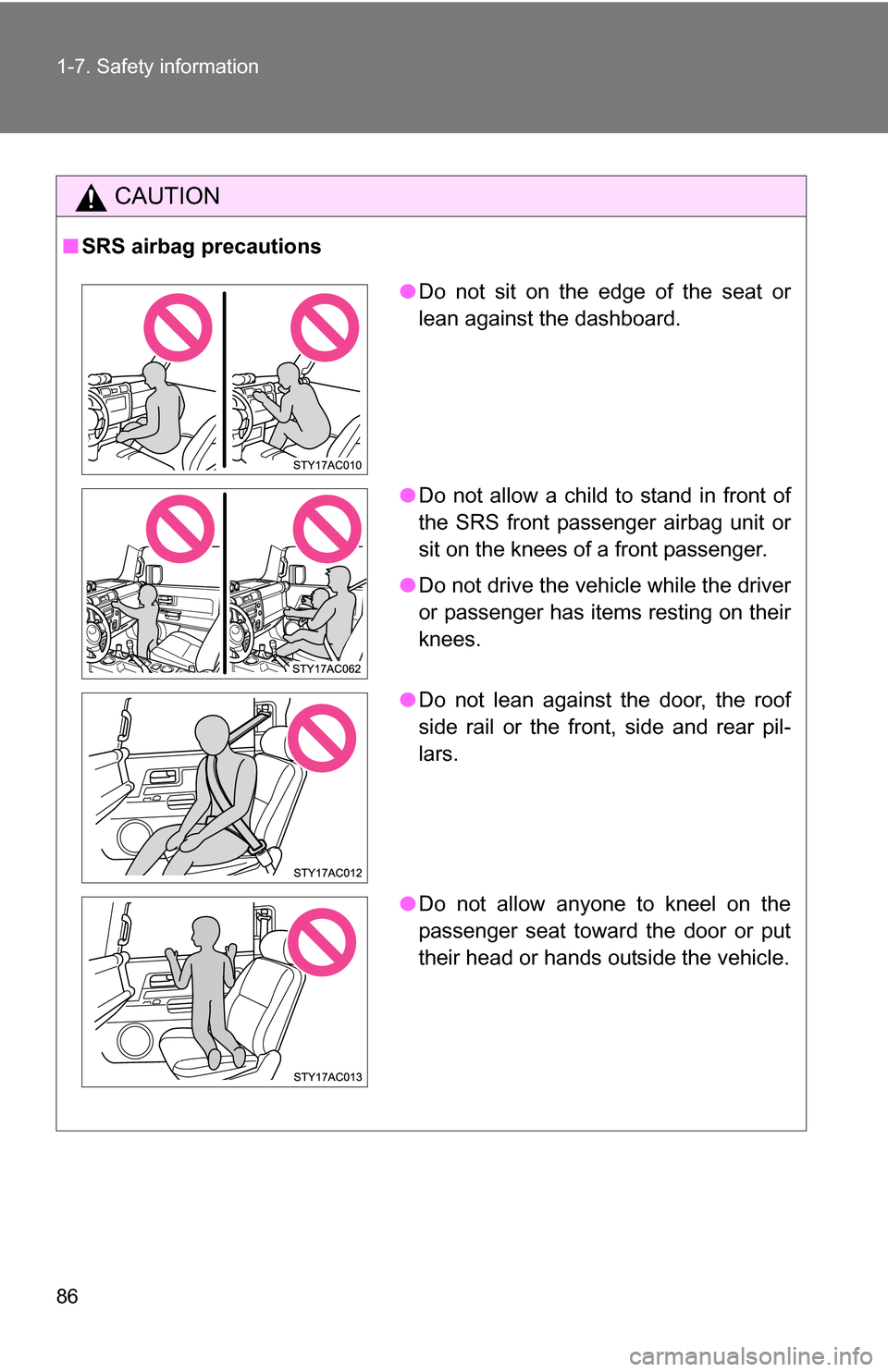
86 1-7. Safety information
CAUTION
■SRS airbag precautions
●Do not sit on the edge of the seat or
lean against the dashboard.
● Do not allow a child to stand in front of
the SRS front passenger airbag unit or
sit on the knees of a front passenger.
● Do not drive the vehicle while the driver
or passenger has items resting on their
knees.
● Do not lean against the door, the roof
side rail or the front, side and rear pil-
lars.
● Do not allow anyone to kneel on the
passenger seat toward the door or put
their head or hands outside the vehicle.